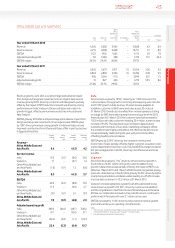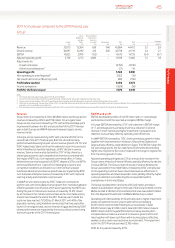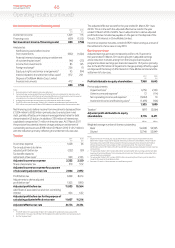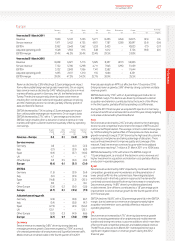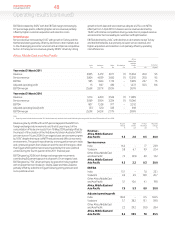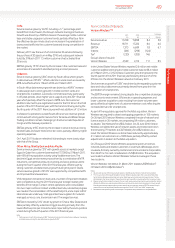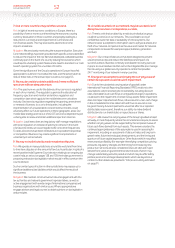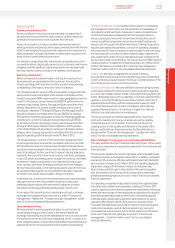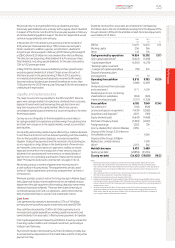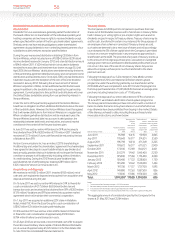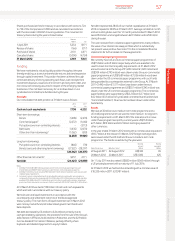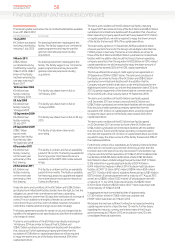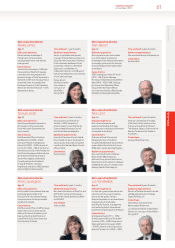Vodafone 2012 Annual Report Download - page 55
Download and view the complete annual report
Please find page 55 of the 2012 Vodafone annual report below. You can navigate through the pages in the report by either clicking on the pages listed below, or by using the keyword search tool below to find specific information within the annual report.
Business review Performance Governance Financials Additional information
53
Vodafone Group Plc
Annual Report 2012
Eurozone risk
Country and currency risk
Recent conditions in the eurozone have resulted in a higher risk of
disruption and business risk from high currency volatility and/or the
potential of an exit of one or more countries from the euro.
As part of our response to these conditions we have reviewed our
existing processes and policies, and in places, evolved them with the aim
of both minimising the Group’s economic exposure and to preserve our
ability to operate in a range of potential conditions that may exist in the
event of one or more of these future events.
Our ability to manage these risks needs to take appropriate account of
our needs to deliver a high quality service to our customers, meet licence
obligations and the signicant capital investments we may have made
and may need to continue to make in the markets most impacted.
Currency related risks
While our share price is denominated in sterling, the majority of our
nancial results are generated in other currencies. As a result the
Group’s operating prot is sensitive to either a relative strengthening
orweakening of the major currencies in which it transacts.
The “Operating results” section of the annual report on pages 40 to 49
sets out a discussion and analysis of the relative contributions of the
Group’s Europe and AMAP regions and the major geographical markets
in each, to the Group’s service revenue and EBITDA performance. Our
markets in Italy, Ireland, Greece, Portugal and Spain have been most
directly impacted by the current market conditions and in order of
contribution, represent 17% (Italy), 8% (Spain), 3% (Portugal) and 3%
(Ireland and Greece combined) of the Group’s EBITDA. An average
3%decline in the sterling equivalent of these combined geographical
markets due to currency revaluation would reduce Group EBITDA
by£0.1 billion. The Group’s foreign currency earnings are diversied
through its 45% equity interest in Verizon Wireless, which operates
inthe United States and generates its earnings in US dollars. Verizon
Wireless, which is equity accounted, contributed 42% of the Group’s
adjusted operating prot for the year ended 31 March 2012.
The Group employs a number of mechanisms to manage elements
ofexchange rate risk at a transaction, translation and economic level.
Atthe transaction level our policies require foreign exchange risks on
transactions denominated in other currencies above certain de minimis
levels to be hedged. Further, since the Company’s sterling share price
represents the value of its future multi-currency cash ows, principally
in euro, US dollars and sterling, we aim to align the currency of our debt
and interest charges in proportion to our expected future principal
multi-currency cash ows, thereby providing an economic hedge in
terms of reduced volatility in the sterling equivalent value of the Group
and a partial hedge against income statement translation exposure,
asinterest costs will be denominated in foreign currencies.
In the event of a country’s exit from the eurozone, this may necessitate
changes in one or more of our entities’ functional currency and
potentially higher volatility of those entities’ trading results when
translated into sterling, potentially adding further currency risk.
A summary of this sensitivity of our operating results and our foreign
exchange risk management policies is set out within “Financial risk
management – Market risk – Foreign exchange management” within
note 21 to the consolidated nancial statements.
Operational planning
We have worked to develop operational plans to use as a basis for
continuity planning across the Group in the event of signicant
exchange rate volatility and/or the withdrawal of one, or a small number
of countries, from the euro. We have categorised “at risk” countries into
three categories based on risk prole and identied three broad areas of
operational risks for the Group where work has been focused, being:
Financial/investment risk: Our activities are focused on counterparty
risk management and in particular the protection and availability of
cashdeposits and investments. Exposures in relation to liquid Group
investments have been reviewed and actions have been taken to
reduce counterparty limits with certain nancial institutions and to
convert a signicant proportion of euro denominated holdings and
deposits into sterling and US dollar investments. Existing Group policy
requires cash sweep arrangements, to ensure no operating company
has more than €5 million on deposit on any one day. Further, the Group
has had in place for a number of years collateral support agreements
with a signicant number of its counterparties to pass collateral to the
Group under certain circumstances. The Group has a net £980 million of
collateral assets in its statement of nancial position at 31 March 2012.
Further information is provided within “Financial risk management –
Credit risk” within note 21 to the consolidated nancial statements.
Trading risks: We have investigated the structure of existing
procurement contracts and we have started the process of amending
certain contractual clauses to place the Group in a better position in the
event of the exit of a country from the eurozone.
Business continuity risks: We have identied a number of key business
continuity priorities which are focused on planning to allow migration
toa more cash-based business model in the event banking systems are
frozen, developing dual currency capability in contract customer billing
systems or ensuring the ability to move these contract customers to
prepaid methods of billing, and the consequential impacts to tariff
structures. We have also put in place contingency plans with key
suppliers that would assist us to continue to support our network
infrastructure, retail operations and employees.
The Group continues to maintain appropriate levels of cash and
short-term investments in many currencies and, with a carefully
controlled group of counterparties, to minimise the risks to the
ongoingaccess to that liquidity and therefore to the ability of the
Groupto settle debts as they become due. Further information is
provided within “Financial risk management – Liquidity risk” within
note21 to the consolidated nancial statements.
Risk of change in carrying amount of assets andliabilities
The main potential short-term nancial statement impact of the current
economic uncertainties is the potential impairment of non-nancial and
nancial assets.
The Group has signicant amounts of goodwill, other intangible assets
and plant, property and equipment allocated to, or held by, companies
operating in the eurozone. We have performed impairment testing for
each country in Europe as at 31 March 2012 and identied aggregate
impairment charges of £4.0 billion in relation to Vodafone Italy,
Spain,Greece and Portugal. Further detail on this exercise together
withthesensitivity of the results of this assessment to reasonably
possible adverse assumptions is set out in note 10 to the consolidated
nancialstatements.
Our operating companies in Italy, Ireland, Greece, Portugal and Spain
have billed and unbilled trade receivables totalling £2.0 billion. IFRS
contains specic requirements for impairment assessments of nancial
assets. We have a range of credit exposures and provisions for doubtful
debts that are generally made by reference to consistently applied
methodologies overlaid with judgements determined on a case-by-
case basis reecting the specic facts and circumstances of the
receivable. Detailed disclosures made in relation to provisions against
loans and receivables as well as disclosures about any loans and
receivables that are past due at the end of the period, concentrations
ofrisk and credit risk more generally as set out in “Financial risk
management – Credit risk” within note 21 to the consolidated
nancialstatements.


